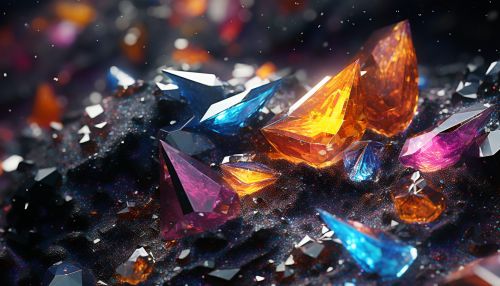Stardust
Introduction
Stardust, often referred to as cosmic dust or space dust, is a type of dust that exists in outer space, as well as on planets and moons. It is composed of particles in space, ranging in size from a few molecules to 0.1 µm, which are ejected from stars or formed through cosmic ray interactions. Stardust is a significant component of the interstellar medium, and plays a crucial role in various astronomical phenomena.


Composition and Formation
Stardust is primarily composed of silicate and graphite grains, with a small percentage of other compounds such as polycyclic aromatic hydrocarbons (PAHs) and water ice. The exact composition of stardust can vary depending on the type of star from which it originated. For example, stardust from red giants is rich in silicates, while stardust from supernovae contains a higher proportion of graphite.
The formation of stardust occurs in the outer atmosphere of stars, where temperatures are cool enough for atoms to combine and form molecules and solid particles. These particles are then expelled into space through stellar winds or supernova explosions. Over time, these particles can accumulate and form larger structures, such as protoplanetary disks, which can eventually give rise to planets and other celestial bodies.
Role in Astronomy
Stardust plays a crucial role in various astronomical phenomena. It serves as the raw material for the formation of celestial bodies, including planets, moons, and asteroids. Stardust also contributes to the interstellar reddening effect, which is the phenomenon of starlight being reddened as it passes through interstellar dust.
In addition, stardust is a key component of the interstellar medium, the matter that fills the space between stars in a galaxy. The interstellar medium is composed of gas and dust, with the dust primarily being stardust. This medium plays a crucial role in star formation, as regions of higher density within the medium can collapse under their own gravity to form new stars.
Study and Research
The study of stardust provides valuable insights into various aspects of astronomy and astrophysics, including the life cycle of stars, the formation of celestial bodies, and the composition of the interstellar medium. Stardust can be studied directly through its impact on Earth or indirectly through astronomical observations.
One of the main methods of studying stardust is through the collection and analysis of micrometeorites, which are small particles of stardust that have fallen to Earth. These particles can be collected from places like Antarctica, where they are preserved in the ice. By analyzing these particles, scientists can determine their composition and origin, providing insights into the types of stars they came from and the processes that formed them.
Astronomical observations also provide a wealth of information about stardust. By observing the light from distant stars and galaxies, astronomers can determine how much dust is present in the interstellar medium and how it affects the propagation of light. This information can be used to infer the properties of the dust, including its composition, size distribution, and spatial distribution.
